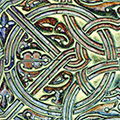Arabian Dreams
 |
||||
| Egyptian fantasies new! |
||||
In 1985 I saw a short film by the Danish artist Niels Nedergård who lived and worked in Cairo. Slow panoramas over dusty roofs in gray, sienna, umber and dull green colors. Very catchy. Very photogenic. Thus, in 1986 and 1987 I made two trips to Egypt together with my friend HC to taste the mysterious desert metropolis Cairo. My friend was studying anthropology with an interest in Islamic culture, and he was easily lured into the project. Of we went in January 1986 for a three weeks stay. We were warned by fellow travelers that Cairo was a terrible town filled with con-men and thieves – we never had a problem while we walked the poorer parts of town, visiting cemeteries and mosques armed with “Islamic monuments in Cairo – a practical guide” and my old Nikon. Under the Islamic ban on depicting faces, the culture developed a rich language of ornaments: foliate arabesques and elaborate geometrical patterns. Photographing these became a goal: domes, vaults, walls, floors, furniture and mihrabs made of colored stone, mother of pearl and wood. A complex world of surfaces, colors and patterns. Before we left Denmark I had obtained the address of Niels Nedergård: Family's Hotel in the old “Islamic Cairo”, and during our stay we made several attempts to find him. This was not easy, as addresses seemed fugitive and Old Cairo is a labyrinth of narrow streets without obvious names. Eventually, we succeeded, finding him at his studio in the remnants of an old merchants house. There he was, painting his fantastic, colored patterns directly inspired by the surrounding ornaments of floors, doors and windows. The visit was a major experience. To get to his workshop on the second floor, you had to balance along a wall on the ceiling joists of an otherwise collapsed building to enter a door in the wall. The room was lit from the opposite side through a huge, ornamental window. The view opened to the dusty roofs and the green, silent atrium of the merchant complex. When we met Niels in 1986, he was just about to have his first exhibition of his works in Cairo. He was very exited about this, not knowing if the local public would see his work as a violation of the old Islamic culture or an aesthetic expansion of its language. Unfortunately, this was one of his last exhibitions – he died at the age of 43 before we returned to Cairo in 1987. Returning home with a pile of kodachromes in the bag, I started exploring the Islamic aesthetic. To the tunes of Brian Enos “My life in the bush of ghosts” and the source recordings Jean Jenkins & Poul Rovsing Olsens “Music in the world of Islam” I started working with the dispositives, producing the Arabesque-series, the first of several works on the source photographs from Cairo 1986-1987. As years passed, Bush declared war against the Islamic culture and the countries of Northern Africa and the middle east engaged in civil wars. I suspect Egypt have changed in many ways but also that the central parts of Islamic Cairo is in essence unchanged with its narrow streets, strong smells and old, dusty buildings. |
||
|
| The Cairo exhibition catalouge |